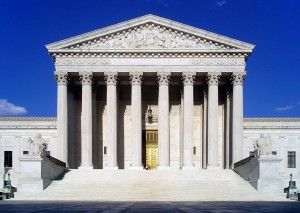Dane Warren
Sabin Center Summer Intern & Rising 2L at Columbia Law School
 On Thursday, June 25, the Affordable Care Act (ACA, also known as Obamacare) withstood another Supreme Court challenge in King v. Burwell. The case focused on a question of statutory interpretation to determine whether those who purchased insurance through federal exchange programs (instead of state-created exchanges) would remain eligible for federal subsidies. Three years ago when the Court considered a constitutional challenge to the ACA in National Federation of Independent Business v. Sebelius, Chief Justice Roberts cast the deciding vote to uphold the centerpiece legislation. This time around, the Chief Justice once again wrote the central opinion, one that could have far reaching effects well beyond health care and federal insurance exchanges.
On Thursday, June 25, the Affordable Care Act (ACA, also known as Obamacare) withstood another Supreme Court challenge in King v. Burwell. The case focused on a question of statutory interpretation to determine whether those who purchased insurance through federal exchange programs (instead of state-created exchanges) would remain eligible for federal subsidies. Three years ago when the Court considered a constitutional challenge to the ACA in National Federation of Independent Business v. Sebelius, Chief Justice Roberts cast the deciding vote to uphold the centerpiece legislation. This time around, the Chief Justice once again wrote the central opinion, one that could have far reaching effects well beyond health care and federal insurance exchanges.
One of the fundamental questions in King v. Burwell involved the oft-cited Chevron deference regime. The doctrine developed by the Supreme Court’s opinion Chevron v. NRDC imposes a two-step analysis for evaluating administrative agency interpretations of a statute that it administers. Under Chevron, the court first asks whether the language and intent of congress is clear. If Congress has not “addressed the precise question at issue”, the court will defer to the agency’s reasonable interpretation of the statute. Many speculated that the Supreme Court would apply the familiar Chevron deference to the ACA in King v. Burwell, perhaps finding ambiguity and deferring to the IRS’s (arguably) reasonable interpretation. The Court instead artfully sidestepped Chevron, holding that Chevron deference might not apply to cases of “deep economic and political significance,” especially if the delegation was not expressly made clear in the statute. Further, the Chief Justice noted that Congress would not have delegated a central health care policy issue to the IRS.[1]
That brings us to the EPA’s forthcoming Clean Power Plan, which for the first time will regulate emissions from existing power sources. Without any major legislation on climate change, the EPA (empowered by the Supreme Court’s 2007 ruling in Massachusetts v. EPA) will soon release groundbreaking rules that the EPA claims will cut power sector emissions 30% compared to 2005 levels. While some have argued that the Plan represents a “diversion from serious climate policy,” the EPA’s actions will almost certainly ruffle feathers in the fossil fuel industry. In fact, industry leaders have already challenged the Clean Power Plan in court based solely on the EPA’s proposal. The DC Circuit proceeded to toss out the suit on the grounds that the EPA had not yet finalized the rule. Once the EPA does so, these suits will begin anew. As one commenter noted, a challenge to the Clean Power Plan has “Supreme Court Review written all over it”. In fact, Professor Lawrence Tribe and his colleagues at Harvard Law School have publically disagreed over the constitutionality of the proposed rules. Professor Michael Gerrard, Director of the Sabin Center for Climate Change Law, has also waded into the debate.
The petitioners in the dismissed suit mentioned above made two basic arguments: first, that the rules would be too costly for states and energy utilities to comply; and second, that the EPA lacks the legal authority to promulgate the rules due to a drafting glitch in the 1990 amendment to the Clean Air Act. The Supreme Court’s June 29 decision in Michigan v. EPA may offer opponents of the Clean Power Plan some fodder for the cost-based argument, but the drafting error argument is likely opponent’s more promising challenge. In 1990, the House and Senate passed two separate technical amendments to Section 111(d) of the Clean Air Act—the statutory basis for the Clean Power Plan—that were never reconciled. According to critics, the relevant section of the House version would preclude the Clean Power Plan because it prohibits EPA regulation of power plants already regulated under other parts of the act, including Section 112, which requires regulation of hazardous air pollutants from existing power plants and was at issue in Michigan v. EPA. On the other hand, the Senate version (Section 111(d)) seems to provide ample authority for the EPA to regulate greenhouse gas emissions.
Just a day after the Supreme Court reached a decision in King v. Burwell, legal scholars started considering its impact on future challenges to the Clean Power Plan. According to commenters, King v. Burwell supports the notion that judges could decline to defer to the agency’s interpretation of Section 111/112 of the Clean Air Act, thereby deciding the fate of the Clean Power Plan. Opponents of the Plan argue that because of the gaff in drafting, Congress did not clearly intend to delegate authority to the EPA. Jeff Holmstead, a former EPA Air and Radiation Assistant Administrator now working in private practice, stated that Congress might not have intended to give the EPA the power to define the outer limits of its own authority. Another commenter has suggested that while the Clean Power Plan rivals the ACA in terms of scope, it did not go through the traditional legislative process, which the Supreme Court might consider problematic.
Supporters of the Clean Power Plan contend that King v. Burwell might play less of a role than industry lawyers hope. First, Chief Justice Roberts explicitly noted that Congress would not be likely to delegate authority to the IRS for complex health policy. In contrast, Congress would certainly delegate authority to the EPA to regulate environmental policy. Further, the Court in King v. Burwell went on to hold that upholding the subsidy provision, despite its poor drafting, was consistent with the overall purpose and context of the ACA. In the same vein, the Clean Air Act’s 1990 Amendment expanded the EPA’s authority to regulate and reduce harmful emissions. The Amendment included the famous acid rain program and increased permitting authority over stationary sources. Similarly, the Supreme Court could find that the overall purpose and context of the Clean Air Act’s 1990 Amendment supports an expansive reading of the EPA’s authority to promulgate the Clean Power Plan rules.
How exactly courts will interpret King v. Burwell in the context of the Clean Power Plan, and administrative law in general, remains to be seen. One thing is clear, however – the Court has proven itself willing to wade into highly politicized agency matters and even sidestep the Chevron deference regime. Time will tell whether that helps or hurts the EPA and the Clean Power Plan.
[1] “Whether those credits are available on Federal Exchanges is thus a question of deep “economic and political significance” that is central to this statutory scheme; had Congress wished to assign that question to an agency, it surely would have done so expressly. Utility Air Regulatory Group v. EPA, 573 U. S. ___, ___ (2014) (slip op., at 19) (quoting Brown & Williamson, 529 U. S., at 160). It is especially unlikely that Congress would have delegated this decision to the IRS, which has no expertise in crafting health insurance policy of this sort. See Gonzales v. Oregon, 546 U. S. 243, 266–267 (2006). This is not a case for the IRS.” King v. Burwell, 2015 WL 2473448, at *8 (U.S. June 25, 2015) (internal citations omitted).




